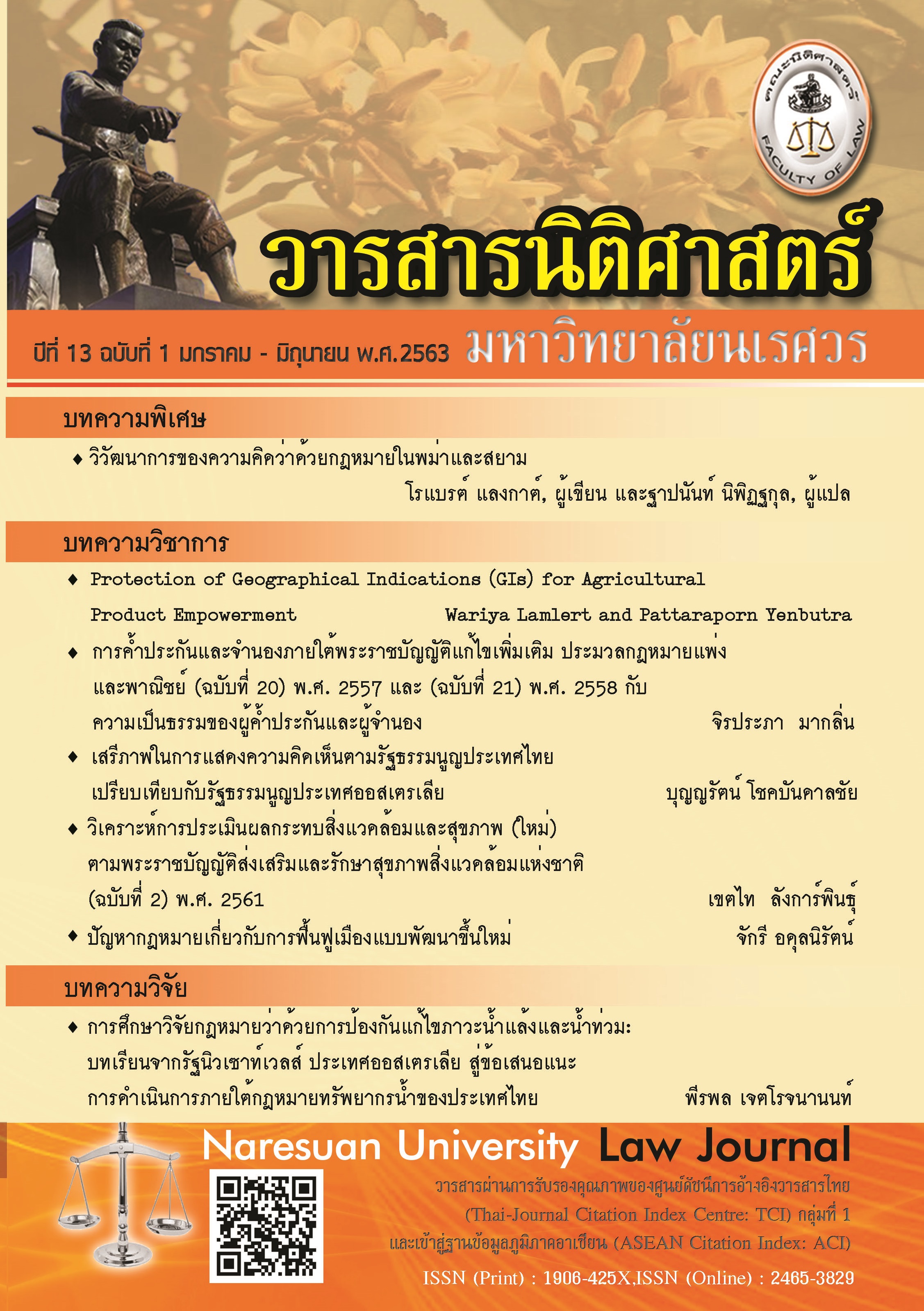Legal Study on Drought and Flood Mitigation: Possible Lessons from New South Wales, Australia towards Implementation of Thai Water Law
Main Article Content
Abstract
Drought and flood mitigation in Thailand has been recently implemented by the existing laws such as Public Disaster Prevention and Mitigation Act B.E. 2550 and other local council laws relating to rescue of people living in the vulnerable areas of drought and flood. In 2018, Thailand significantly launched its first water law, namely as Water Resources Act B.E. 2561 which becomes a key instrument for water management in the country because the Thai government provided an effort to establish the managerial system for water resources in accordance with sustainability and unity. Moreover, as approved by the government, the Office of the National Water Resources (ONWR) was established to implement and support such water law as it plays important roles in controlling and managing Thailand’s water resources systematically. This does not mean that, nevertheless, Water Resources Act B.E. 2561 would preclude other existing laws concerning drought and flood mitigation. In contrast, this water law shall be enforced and implemented in the line of integration and cooperation with other existing laws and regulations. The enforcement and implementation of drought and flood mitigation would not fall into only one state agency or organization, but it shall be also functioned together with other state organs and relevant laws. According to the survey, Australia provides an integrated model of drought and flood mitigation which would be interesting and outstanding to be studied and applied to legal development of Thai water law. This research article mainly aims to present and determine possible lessons from what the Australian government did for its drought and flood mitigation so as to design recommendations for Thailand.
Article Details
References
Bates, Gerry. Environmental Law in Australia. 7th ed. NSW: LexisNexis, 2010.
Carbone, Delana, and Jenna Hanson. “Top 10 Worst Floods in Australia.” Last modified March 8, 2012. Accessed September 5, 2019. https://www.australiangeographic.com.au/topics/history-culture/2012/03/floods-10-of-thedeadliest-in-australian-history/.
Central Intelligence Agency. “The World Fact Book: Australia.” Accessed September 5, 2019. https://www.cia.gov/-library/publications/the-world-factbook/geos/as.html.
Department of Infrastructure, Planning and Natural Resources (New South Wales Government). Floodplain Development Manual: The Management of Flood Liable Land. NSW: Department of Infrastructure, Planning and Natural Resources, 2005.
Independent Pricing and Regulatory Tribunal. “Who We Are?.” Accessed September 22, 2019, https://www.ipart.nsw.gov.au/Home.
Meek, Michael. Australian Legal System. 4th ed. NSW: Thomson Lawbook, 2008.
NSW Department of Primary Industries. “About the NSW DPI Combined Drought Indicator.” Accessed September 20, 2019. https://edis.dpi.nsw.gov.au/about.
NSW Department of Primary Industries. “Drought in NSW.” Accessed September 20, 2019. https://www.dpi.nsw.gov.au/climate-and-emergencies/droughthub/droughtin-nsw.
NSW Department of Primary Industries. “Independent Regional Assistance Advisory Committee (RAAC).” Accessed September, 20, 2019. https://www.dpi.nsw.gov.au/climate-and-emergencies/droughthub/information-and-resources/raac.
Office of the National Water Resources. Action Plan for Water Crisis Mitigation. Bangkok: Office of the National Water Resources. 2019. [In Thai]
Water NSW. “Flood Work Approvals: What is a Flood Work?.” Accessed September 14, 2019. https://www.waternsw.com.au/customer-service/water-licensing/approvals/flood-work-approvals.
Water NSW. “Who We Are?.” Accessed September 15, 2019. https://www.waternsw.com.au/about/who-we-are.
WMA Water. Lake Macquarie Waterway Flood Risk Management Study and Plan (Research Report). NSW: Public Exhibition Project, 2011.


